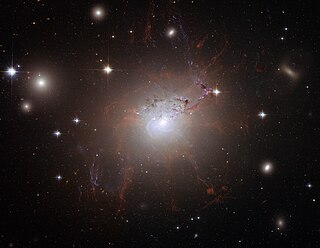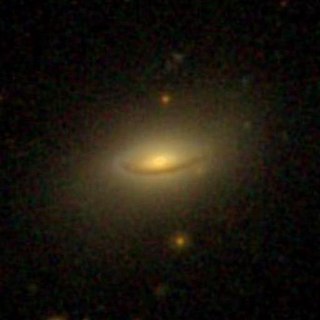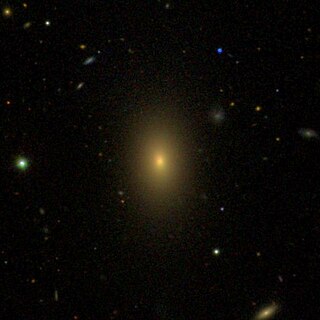
NGC 1275 is a type 1.5 Seyfert galaxy located around 237 million light-years away in the direction of the constellation Perseus. NGC 1275 is a member of the large Perseus Cluster of galaxies.

3C 305, also known as IC 1065, is a lenticular galaxy located in the constellation Draco. The galaxy is located 577 million light-years away from Earth. It has an active galactic nucleus and is classified as a Seyfert 2 galaxy. This galaxy was discovered by American astronomer Lewis Swift on April 7, 1888.

RX J1532.9+3021 is a galaxy cluster located in the constellation of Corona Borealis. It has a velocity of 103,539 ± 8 kilometers per second, equivalent to a Hubble distance of 1,527.1 ± 106.9 megaparsecs or 3.9 billion light years. It is classfied one of the massive and strongest X-ray bright cool clusters in the universe at redshift z = 0.362. The luminosity of the cluster is estimated to be 6 x 1045 ergs−1. According to a study published in 2013, a mini radio halo is seen surrounding the cluster.

NGC 708 is an elliptical galaxy located 240 million light-years away in the constellation Andromeda and was discovered by astronomer William Herschel on September 21, 1786. It is classified as a cD galaxy and is the brightest member of Abell 262. NGC 708 is a weak FR I radio galaxy and is also classified as a type 2 Seyfert galaxy.

NGC 741, also known as PGC 7252, is a formerly active radio galaxy in the constellation of Pisces. Located 74.13 Mpc away, NGC 741 is part of a group of galaxies including NGC 742 and PGC 7250. NGC 741 and NGC 742 recently collided, although the disruption was minor. Radio filaments have been found connecting NGC 741 to NGC 742, and due to the bent structure of the radio filaments, NGC 741 is estimated to be moving at 1400 km/s with respect to its local group, suggesting that ram-pressure stripping was created as a product of the former merger.

NGC 4636 is an elliptical galaxy located in the constellation Virgo. It is a member of the NGC 4753 Group of galaxies, which is a member of the Virgo II Groups, a series of galaxies and galaxy clusters strung out from the southern edge of the Virgo Supercluster. It is located at a distance of about 55 million light years from Earth, which, given its apparent dimensions, means that NGC 4636 is about 105,000 light years across.

NGC 5846 is an elliptical galaxy located in the constellation Virgo. It is located at a distance of circa 90 million light years from Earth, which, given its apparent dimensions, means that NGC 5846 is about 110,000 light years across. It was discovered by William Herschel on February 24, 1786. It lies near 110 Virginis and is part of the Herschel 400 Catalogue. It is a member of the NGC 5846 Group of galaxies, itself one of the Virgo III Groups strung out to the east of the Virgo Supercluster of galaxies.

NGC 4074 is a peculiar lenticular galaxy located 310 million light-years away in the constellation Coma Berenices. It was discovered by astronomer William Herschel on April 27, 1785 and is a member of the NGC 4065 Group.

The Teacup galaxy, also known as the Teacup AGN or SDSS J1430+1339 is a low redshift type 2 quasar, showing an extended loop of ionized gas resembling a handle of a teacup, which was discovered by volunteers of the Galaxy Zoo project and labeled as a Voorwerpje.

NGC 4324 is a lenticular galaxy located about 85 million light-years away in the constellation Virgo. It was discovered by astronomer Heinrich d'Arrest on March 4, 1862. NGC 4324 has a stellar mass of 5.62 × 1010M☉, and a baryonic mass of 5.88 × 1010M☉. The galaxy's total mass is around 5.25 × 1011M☉. NGC 4324 is notable for having a ring of star formation surrounding its nucleus. It was considered a member of the Virgo II Groups until 1999, when its distance was recalculated and it was placed in the Virgo W Group.

An extended emission-line region (EELR) is a giant interstellar cloud ionized by the radiation of an active galactic nucleus (AGN) inside a galaxy or photons produced by the shocks associated with the radio jets. An EELR can appear as a resolved cloud in relative nearby galaxies and as narrow emission lines in more distant galaxies.

4C+55.16 is an elliptical galaxy, classified type E, located in Ursa Major. The galaxy lies about 2.84 billion light-years from Earth, which means given its apparent dimensions, 4C+55.16 is approximately 445,000 light-years across making it a type-cD galaxy. It is the brightest cluster galaxy (BCG) in a cluster of the same name.

IRAS 09104+4109 is a galaxy located in the constellation Lynx. With a redshift of 0.440797, the light travel time for this galaxy, corresponds to 4.8 billion light-years from Earth. It is the brightest cluster galaxy in MACS J0913.7+4056 galaxy cluster and classified as a hyperluminous infrared galaxy.

NGC 4325 is an elliptical galaxy located about 330 million light-years away in the constellation Virgo. It was discovered by astronomer Heinrich d'Arrest on April 15, 1865, who described it as "vF, vS, iR, nf of 2". Despite being listed in the Virgo Cluster catalog as VCC 616, it is not a member of the Virgo Cluster but instead a background galaxy.

4C +26.42 is an elliptical galaxy located in the constellation of Boötes. It has a redshift of 0.063, estimating the galaxy to be located 863 million light-years from Earth. It has an active galactic nucleus and is the brightest cluster galaxy (BCG) in Abell 1795, an X-ray luminous rich cluster (LX 1045 ergs s−1), with an estimated cooling-flow rate of 300 M yr−1.

NGC 6051 is a giant elliptical galaxy located in the constellation of Serpens. The galaxy lies 453 million light-years from Earth, which means given its apparent dimensions, the galaxy is around 250,000 light-years across. It is the brightest cluster galaxy inside a relaxed poor cluster called AWM 4, a fossil system, making up of at least 30 galaxy members.

Markarian 463 known as UGC 8850, is a galaxy merger located in the constellation Boötes. It is located 706 million light years from Earth. It is classified a double nucleus Seyfert galaxy.

3C 196.1 is a low-excitation radio galaxy located in the constellation of Hydra. It has a redshift of 0.198 and was first discovered as an astronomical radio source in 1965. This object resides as the brightest cluster galaxy (BCG) of a cool core galaxy cluster CIZA J0815.4-0308 located at the same redshift, with its source being best described as a HyMOR.

3C 382 is a nearby broad-line radio galaxy located in the constellation of Lyra, located at a redshift of (z) 0.058. First discovered as an astronomical radio source in 1963 and identified with its optical counterpart in 1973, the galaxy is classified as a Fanaroff-Riley class II radio galaxy. Its X-ray luminosity is estimated to be 7×1044 erg/s in the 0.2–2.4 keV band.



















